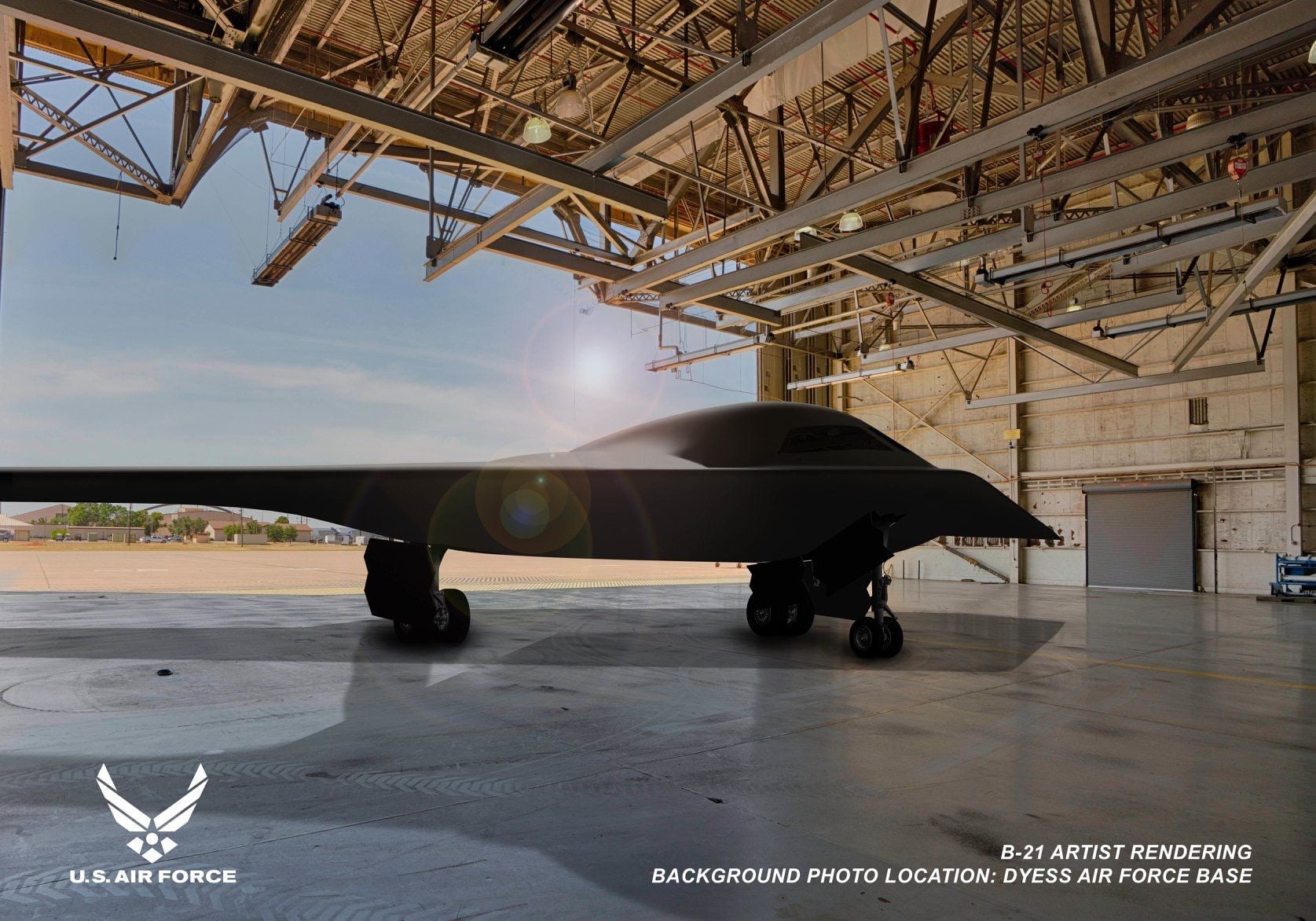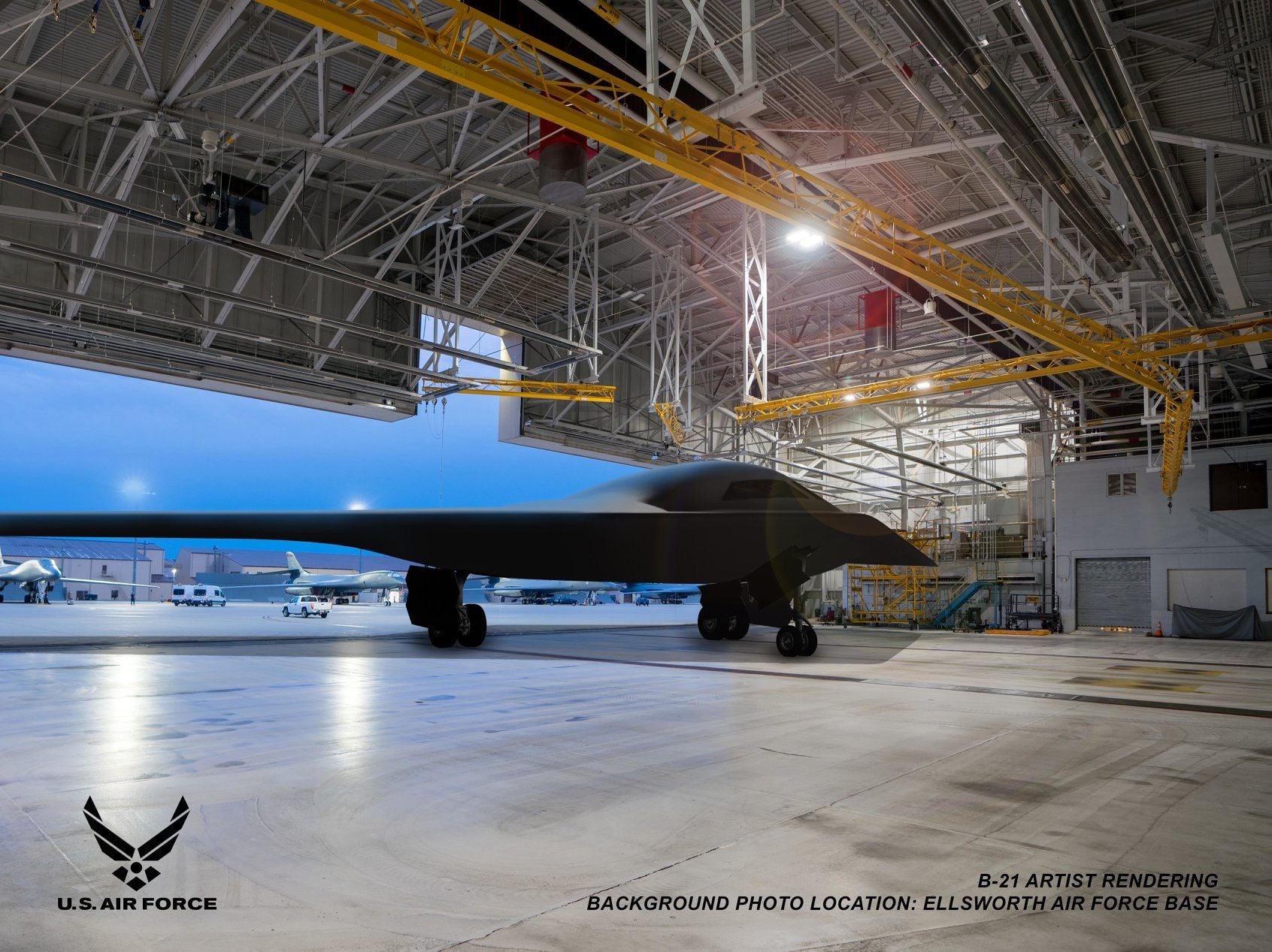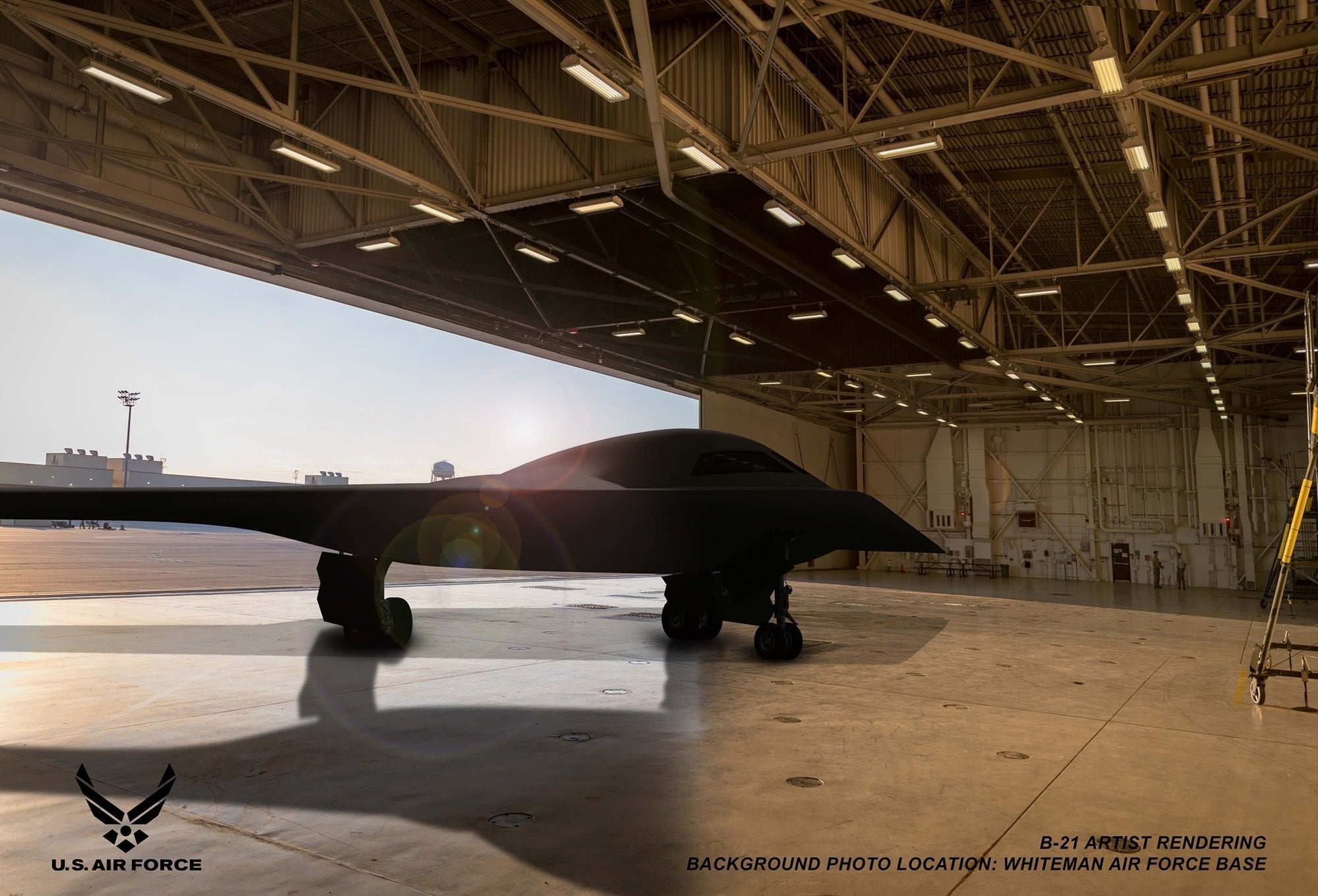LRS-B... The B-21
If I am interpreting this statement correctly, it sounds like the first test aircraft - not just an iron bird - is already in production:
https://www.afmc.af.mil/News/Article...UbyCgWS4xZGOA/
https://www.afmc.af.mil/News/Article...UbyCgWS4xZGOA/
Ideas being floated down here that Australia could partner with the US in B-21 development, as a replacement for F-111 lost capability.
https://www.defenceconnect.com.au/st...-participation
At the moment, just wishful thinking...
https://www.defenceconnect.com.au/st...-participation
At the moment, just wishful thinking...
Ecce Homo! Loquitur...
EDWARDS AIR FORCE BASE, Calif. --
The 420th Flight Test Squadron was reactivated following an assumption of command ceremony here Oct. 4. The squadron will plan, test, analyze and report on all flight and ground testing of the B-21 Raider.
The 420 FLTS is organized under the 412th Test Wing, which is part of the Air Force Test Center, headquartered at Edwards. The squadron, along with the Air Force Rapid Capabilities Office, will ensure the Air Force delivers this asymmetric capability to the warfighter.
The B-21 will be a highly survivable, next-generation bomber with the ability to penetrate modern air defenses and hold any target at risk globally. The program has a mature and stable design and is transitioning to manufacturing development of the first test aircraft in Palmdale, California.
“The first flight of the Raider will take it from Palmdale to Edwards AFB, where the legacy of excellence will continue with the reactivation of the 420th Flight Test Squadron,” said Acting Secretary of the Air Force Matthew Donovan, during the Air Force Association Conference Sept. 16.
This legacy of excellence began July 17, 1989, when the B-2 Spirit, the world’s first stealth bomber, took off from Northrop Grumman’s production facility at Plant 42 in Palmdale, and landed 112 minutes later at Edwards for developmental testing by the 420th FLTS.
The 420th Flight Test Squadron was reactivated following an assumption of command ceremony here Oct. 4. The squadron will plan, test, analyze and report on all flight and ground testing of the B-21 Raider.
The 420 FLTS is organized under the 412th Test Wing, which is part of the Air Force Test Center, headquartered at Edwards. The squadron, along with the Air Force Rapid Capabilities Office, will ensure the Air Force delivers this asymmetric capability to the warfighter.
The B-21 will be a highly survivable, next-generation bomber with the ability to penetrate modern air defenses and hold any target at risk globally. The program has a mature and stable design and is transitioning to manufacturing development of the first test aircraft in Palmdale, California.
“The first flight of the Raider will take it from Palmdale to Edwards AFB, where the legacy of excellence will continue with the reactivation of the 420th Flight Test Squadron,” said Acting Secretary of the Air Force Matthew Donovan, during the Air Force Association Conference Sept. 16.
This legacy of excellence began July 17, 1989, when the B-2 Spirit, the world’s first stealth bomber, took off from Northrop Grumman’s production facility at Plant 42 in Palmdale, and landed 112 minutes later at Edwards for developmental testing by the 420th FLTS.
Airforcemag article
Little bit by little bit, more is being revealed about the Raider. Though could it be another F-117 misleading re the shape when the Pentagon showed off a short stubby airframe artists impression.
https://www.airforcemag.com/article/...r-takes-shape/

https://www.airforcemag.com/article/...r-takes-shape/

Ecce Homo! Loquitur...
https://www.airforcetimes.com/news/y...is-the-future/
Air Force general: Two-bomber fleet is the future
The future of the Air Force’s bomber fleet will be the B-21 Raider, now under development, and a heavily modified version of the Cold War-era B-52 Stratofortress, Lt. Gen. David Nahom, deputy chief of staff for plans and programs, told lawmakers on Thursday.
Nahom said getting to that two-bomber fleet is important as the Air Force shifts to a strategy focused on what the Pentagon calls “great power competition” — preparing for a conflict with a peer or near-peer nation such as China or Russia. “On the bomber fleet, there’s nothing more important to the Air Force,” Nahom told the House Armed Services subcommittee on seapower and projection forces. “If you look at what the bombers bring, no one else brings it. Our joint partners don’t bring it, our coalition partners don’t bring it.”
The B-1B Lancer and B-2 Spirit are important in the meantime, and each bring important capabilities, Nahom said. The B-2′s ability to penetrate enemy airspace and carry nuclear weapons, and the volume of ordnance the B-1 can carry, make each aircraft crucial for now, he said. The Air Force needs to keep the B-2 until the B-21 is delivered and nuclear-certified, he said, which will likely take about a decade.
Keeping the B-1 is trickier, Nahom said, largely because the Air Force has flown it so hard over the last several years. “We’ve used that airplane, and overused it over many years,” Nahom said of the B-1. “It’s broken, in many ways.”
The Air Force reported a 51.75 percent mission-capable rate for its 62 Lancers in 2018. But last August, Gen. John Hyten, now vice chairman of the Joint Chiefs of Staff, told lawmakers that just six B-1 Lancers were fully mission-capable, indicating the fleet is in much worse shape than was previously known. Some B-1s at Ellsworth and Dyess Air Force bases are so far gone, Nahom said, that it made more sense to take them offline. That way, maintainers could instead focus on fixing the Lancers that have a better shot at returning to flying status, he said. That’s why the Air Force proposed cutting 17 B-1s as part of its fiscal 2021 budget, released earlier this month.
“That takes the worst actors offline, and lets the maintainers now concentrate on the airplanes that have a better road to recovery,” Nahom said. “We think, by doing this, we’ll get the mission-capable rate to a more acceptable level.” By doing that, Nahom said, the Air Force should be able to maintain the B-1 fleet until the B-21 becomes operational.
Rep. Mike Conaway, R-Texas, noted that the Air Force is talking about retiring relatively younger aircraft and keeping the much-older B-52s — some of which might be flying until they’re 100 years old.
While Nahom acknowledged that many B-52s are old in years, they’re relatively young in terms of flying hours, because they sat on nuclear alert during the Cold War and weren’t flown as hard. By upgrading key parts of the B-52, including replacing engines, adding a new radar and other new technologies, “we’re going to be able to do things with that airplane that we would not be able to do with a B-1 or a B-2,” Nahom said.
The re-engining of the B-52 is going well, and the service’s request for proposal should be released this year, said Will Roper, assistant secretary of the Air Force for acquisition, technology and logistics. Roper also quoted Indiana Jones as he discussed the B-52′s potential longevity: “It’s not the years, it’s the mileage. That very much applies to airplanes.”
Air Force general: Two-bomber fleet is the future
The future of the Air Force’s bomber fleet will be the B-21 Raider, now under development, and a heavily modified version of the Cold War-era B-52 Stratofortress, Lt. Gen. David Nahom, deputy chief of staff for plans and programs, told lawmakers on Thursday.
Nahom said getting to that two-bomber fleet is important as the Air Force shifts to a strategy focused on what the Pentagon calls “great power competition” — preparing for a conflict with a peer or near-peer nation such as China or Russia. “On the bomber fleet, there’s nothing more important to the Air Force,” Nahom told the House Armed Services subcommittee on seapower and projection forces. “If you look at what the bombers bring, no one else brings it. Our joint partners don’t bring it, our coalition partners don’t bring it.”
The B-1B Lancer and B-2 Spirit are important in the meantime, and each bring important capabilities, Nahom said. The B-2′s ability to penetrate enemy airspace and carry nuclear weapons, and the volume of ordnance the B-1 can carry, make each aircraft crucial for now, he said. The Air Force needs to keep the B-2 until the B-21 is delivered and nuclear-certified, he said, which will likely take about a decade.
Keeping the B-1 is trickier, Nahom said, largely because the Air Force has flown it so hard over the last several years. “We’ve used that airplane, and overused it over many years,” Nahom said of the B-1. “It’s broken, in many ways.”
The Air Force reported a 51.75 percent mission-capable rate for its 62 Lancers in 2018. But last August, Gen. John Hyten, now vice chairman of the Joint Chiefs of Staff, told lawmakers that just six B-1 Lancers were fully mission-capable, indicating the fleet is in much worse shape than was previously known. Some B-1s at Ellsworth and Dyess Air Force bases are so far gone, Nahom said, that it made more sense to take them offline. That way, maintainers could instead focus on fixing the Lancers that have a better shot at returning to flying status, he said. That’s why the Air Force proposed cutting 17 B-1s as part of its fiscal 2021 budget, released earlier this month.
“That takes the worst actors offline, and lets the maintainers now concentrate on the airplanes that have a better road to recovery,” Nahom said. “We think, by doing this, we’ll get the mission-capable rate to a more acceptable level.” By doing that, Nahom said, the Air Force should be able to maintain the B-1 fleet until the B-21 becomes operational.
Rep. Mike Conaway, R-Texas, noted that the Air Force is talking about retiring relatively younger aircraft and keeping the much-older B-52s — some of which might be flying until they’re 100 years old.
While Nahom acknowledged that many B-52s are old in years, they’re relatively young in terms of flying hours, because they sat on nuclear alert during the Cold War and weren’t flown as hard. By upgrading key parts of the B-52, including replacing engines, adding a new radar and other new technologies, “we’re going to be able to do things with that airplane that we would not be able to do with a B-1 or a B-2,” Nahom said.
The re-engining of the B-52 is going well, and the service’s request for proposal should be released this year, said Will Roper, assistant secretary of the Air Force for acquisition, technology and logistics. Roper also quoted Indiana Jones as he discussed the B-52′s potential longevity: “It’s not the years, it’s the mileage. That very much applies to airplanes.”
Maybe this is a dumb question, but if many of the B-1Bs are in such sad shape, they parked ~20 B-1Bs several years ago (I'm thinking around year 2000, when they were relatively young) to concentrate limited resources on the remaining fleet. Wouldn't it make sense to take those aircraft out of mothballs, update them with the latest kit from the most heavily used B1, and bring them back on-line?
Join Date: Dec 2018
Location: Dundee
Posts: 2
Likes: 0
Received 0 Likes
on
0 Posts
Maybe this is a dumb question, but if many of the B-1Bs are in such sad shape, they parked ~20 B-1Bs several years ago (I'm thinking around year 2000, when they were relatively young) to concentrate limited resources on the remaining fleet. Wouldn't it make sense to take those aircraft out of mothballs, update them with the latest kit from the most heavily used B1, and bring them back on-line?
See you and your logic td....
Maybe this is a dumb question, but if many of the B-1Bs are in such sad shape, they parked ~20 B-1Bs several years ago (I'm thinking around year 2000, when they were relatively young) to concentrate limited resources on the remaining fleet. Wouldn't it make sense to take those aircraft out of mothballs, update them with the latest kit from the most heavily used B1, and bring them back on-line?
The current fleet B-1B have had major upgrades over the last few years - not likely to be regenerating any from the boneyard unless the fleet goes below a critical level before its planned retirement date.
RAFE, I suspect you are in a far better position to know, but this bit:
Really, 10% mission capable? Yes, I know taking new kit and putting it on an older airframe is not trivial, but 10%? That implies some serious structural issues that are not going away.
But last August, Gen. John Hyten, now vice chairman of the Joint Chiefs of Staff, told lawmakers that just six B-1 Lancers were fully mission-capable, indicating the fleet is in much worse shape than was previously known. Some B-1s at Ellsworth and Dyess Air Force bases are so far gone, Nahom said, that it made more sense to take them offline. That way, maintainers could instead focus on fixing the Lancers that have a better shot at returning to flying status, he said.
It's probably a reasoned decision that they don't need more right now with operations winding down in Afghanistan, the Turks & Russians beating on each other in Syria & China hamstrung by the virus.
Time to get all those upgrades & maintenance done
Time to get all those upgrades & maintenance done
No...
Interesting that the linked article notes Orbital ATK as a major subcontractor. Their primary product is solid propellant rocket motors (they did the solid boosters for the Space Shuttle and are providing the solid strap-ons for the SLS) - rather curious what they'd be doing for the B-21.
Interesting that the linked article notes Orbital ATK as a major subcontractor. Their primary product is solid propellant rocket motors (they did the solid boosters for the Space Shuttle and are providing the solid strap-ons for the SLS) - rather curious what they'd be doing for the B-21.
No...
Interesting that the linked article notes Orbital ATK as a major subcontractor. Their primary product is solid propellant rocket motors (they did the solid boosters for the Space Shuttle and are providing the solid strap-ons for the SLS) - rather curious what they'd be doing for the B-21.
Interesting that the linked article notes Orbital ATK as a major subcontractor. Their primary product is solid propellant rocket motors (they did the solid boosters for the Space Shuttle and are providing the solid strap-ons for the SLS) - rather curious what they'd be doing for the B-21.
Ecce Homo! Loquitur...
Think they had a fair bit of work on composite structures, so perhaps not so strange.
“Orbital ATK has successfully completed the production of the 5,000th composite part for Lockheed Martin’s F-35 Lightning II joint strike fighter aircraft.....
The company currently produces approximately 90% of the upper and lower wing skins, engine nacelles, access covers, and fixed skins for the F-35 aircraft at its Aerospace Structures Division facility in Clearfield, Utah, US.”.......
Accents over Groom and Loyal Wingman
Ideas being floated down here that Australia could partner with the US in B-21 development, as a replacement for F-111 lost capability.
https://www.defenceconnect.com.au/st...-participation
At the moment, just wishful thinking...
https://www.defenceconnect.com.au/st...-participation
At the moment, just wishful thinking...

Tbh also with Loyal Wingman program sold to RAAF and already entering service with one airframe, says it all about special relationship is a tad different to our one.
Then again what’s Austtalian strategic vision regarding the pacific areas and if we had the dish could we partake or even in an alternate universe go back to the days of strategic bombing...
cheers
Last edited by chopper2004; 18th Aug 2020 at 23:23.
Join Date: Feb 2006
Location: Hanging off the end of a thread
Posts: 33,072
Received 2,940 Likes
on
1,252 Posts
Ideas being floated down here that Australia could partner with the US in B-21 development, as a replacement for F-111 lost capability.
https://www.defenceconnect.com.au/st...-participation
At the moment, just wishful thinking...
https://www.defenceconnect.com.au/st...-participation
At the moment, just wishful thinking...






